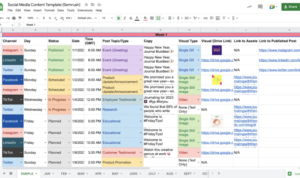Creating a Blogging Schedule sets the foundation for a thriving blog, ensuring consistency and engaging content that keeps readers coming back for more.
Importance of a Blogging Schedule
Having a consistent blogging schedule is crucial for a successful blog as it helps in maintaining reader engagement and loyalty. It also plays a significant role in improving and organic traffic growth.
Maintaining Reader Engagement and Loyalty
A well-planned blogging schedule ensures that your audience knows when to expect new content, which can lead to increased reader engagement and loyalty. By consistently providing valuable and timely posts, you can build a loyal following who will keep coming back for more.
Impact on and Organic Traffic Growth
Search engines value fresh and relevant content, and having a consistent blogging schedule can help improve your rankings. Regularly publishing high-quality content can attract more visitors to your blog, leading to increased organic traffic over time.
Designing Your Blogging Schedule

Deciding on how often to post, creating a sustainable schedule, and planning content in advance are crucial aspects of maintaining a successful blog.
Determining Your Posting Frequency
- Consider your niche and audience: Understand how often your target audience expects new content and how frequently similar blogs in your niche post.
- Personal capacity: Evaluate how much time you can realistically dedicate to creating quality posts without burning out.
- Experiment and analyze: Start with a posting frequency (e.g., once a week) and monitor engagement metrics to adjust as needed.
Creating a Realistic Schedule
- Set achievable goals: Be honest about the time you can commit and create a schedule that aligns with your availability.
- Establish a routine: Consistency is key, so choose specific days and times to post to build anticipation and trust with your audience.
- Allow flexibility: Life happens, so build in buffer time for unexpected events or breaks without compromising your schedule.
Benefits of Planning Content in Advance, Creating a Blogging Schedule
- Consistent quality: Preparing content ahead allows you to maintain high standards and avoid rushed or subpar posts.
- Improved organization: Planning helps you stay focused, manage your time efficiently, and avoid last-minute stress.
- Enhanced creativity: Having a content calendar in place gives you time to brainstorm ideas, research, and craft engaging posts.
Tools and Resources for Managing Your Blogging Schedule

In the world of blogging, staying organized and on top of your content schedule is crucial for success. Fortunately, there are several tools and resources available to help you manage your blogging schedule efficiently.
Content Calendar Tools
- WordPress Editorial Calendar: A popular plugin for WordPress users, allows you to see all your scheduled posts in one place and easily drag and drop to reschedule.
- CoSchedule: A comprehensive tool that not only helps with scheduling blog posts but also integrates with social media platforms for promotion.
- Google Calendar: A free and simple option for creating a content calendar, with the ability to color code different types of content for easy organization.
Automation Tools for Blogging
- Hootsuite: A social media management tool that allows you to schedule posts in advance, including sharing your blog content on various platforms.
- Buffer: Another social media scheduling tool that can be integrated with your blog to automatically share new posts as soon as they are published.
- Zapier: A platform that helps automate workflows by connecting different apps and services, making it easier to streamline your blogging process.
Adapting and Evolving Your Blogging Schedule: Creating A Blogging Schedule
As a blogger, it’s important to be able to adapt and evolve your schedule based on various factors. Whether it’s audience feedback, analytics, seasonal changes, or new strategies, being flexible is key to success.
Adjusting Based on Audience Feedback and Analytics
When it comes to adapting your schedule based on audience feedback and analytics, there are a few strategies you can implement:
- Monitor your website traffic and engagement metrics regularly to identify patterns and trends.
- Use feedback from comments, surveys, and social media to understand what your audience wants.
- Experiment with different posting times and frequency to see what works best for your audience.
Incorporating Seasonal Content and Promotions
Seasonal content and promotions can add a dynamic element to your blogging schedule. Here are some tips for incorporating them:
- Create a content calendar that includes seasonal themes and events relevant to your niche.
- Plan ahead for holidays, seasons, and special events to ensure timely and engaging content.
- Promote seasonal sales, discounts, or special offers through your blog posts to drive traffic and conversions.
Staying Flexible and Adapting to Changes
Staying flexible and adapting to changes in your blogging strategy is essential for long-term success. Here are some tips to help you stay on top of your game:
- Be open to trying new content formats, topics, and platforms based on emerging trends.
- Regularly review and adjust your blogging schedule to reflect changes in your goals and priorities.
- Don’t be afraid to pivot or shift focus if certain topics or strategies are not resonating with your audience.











